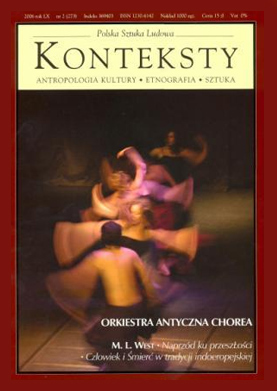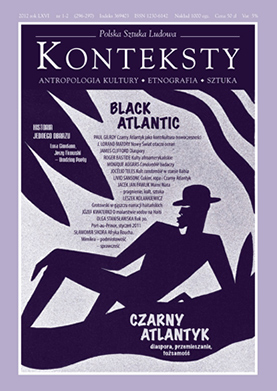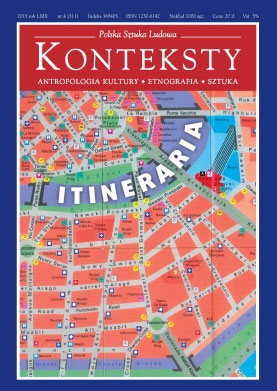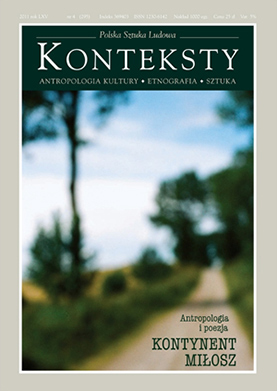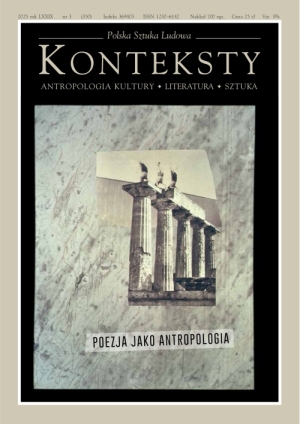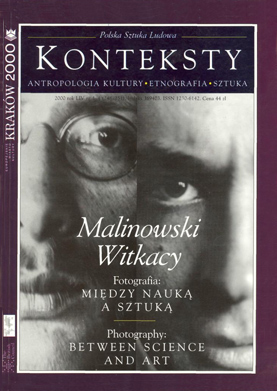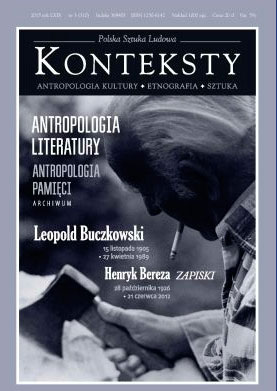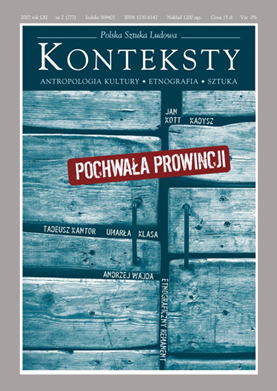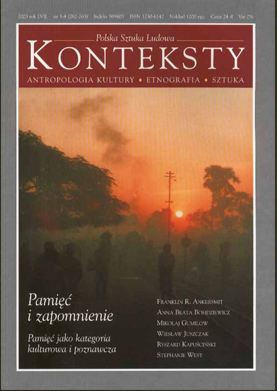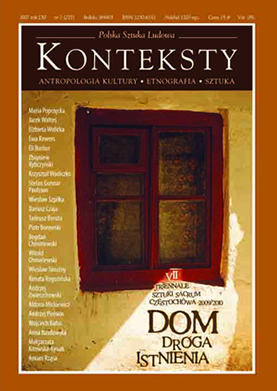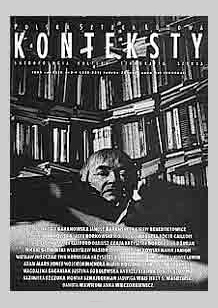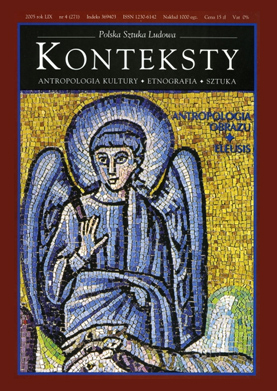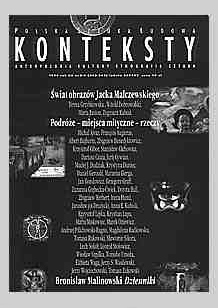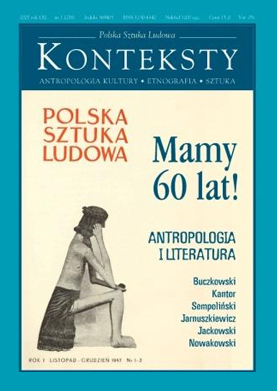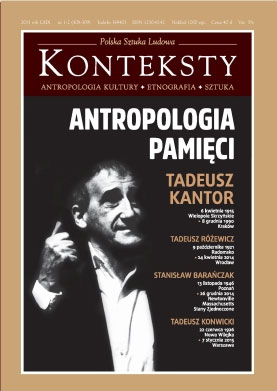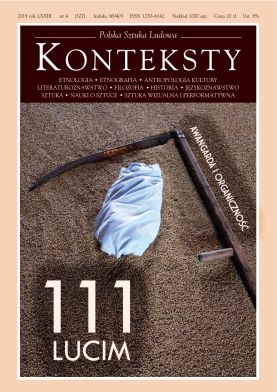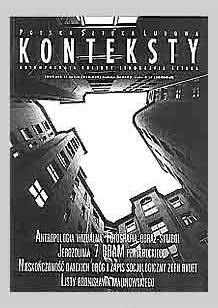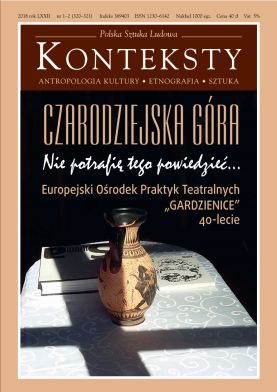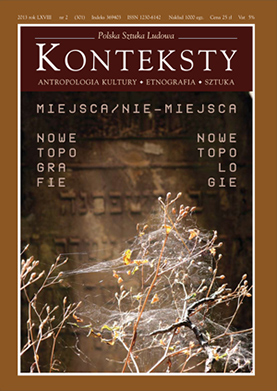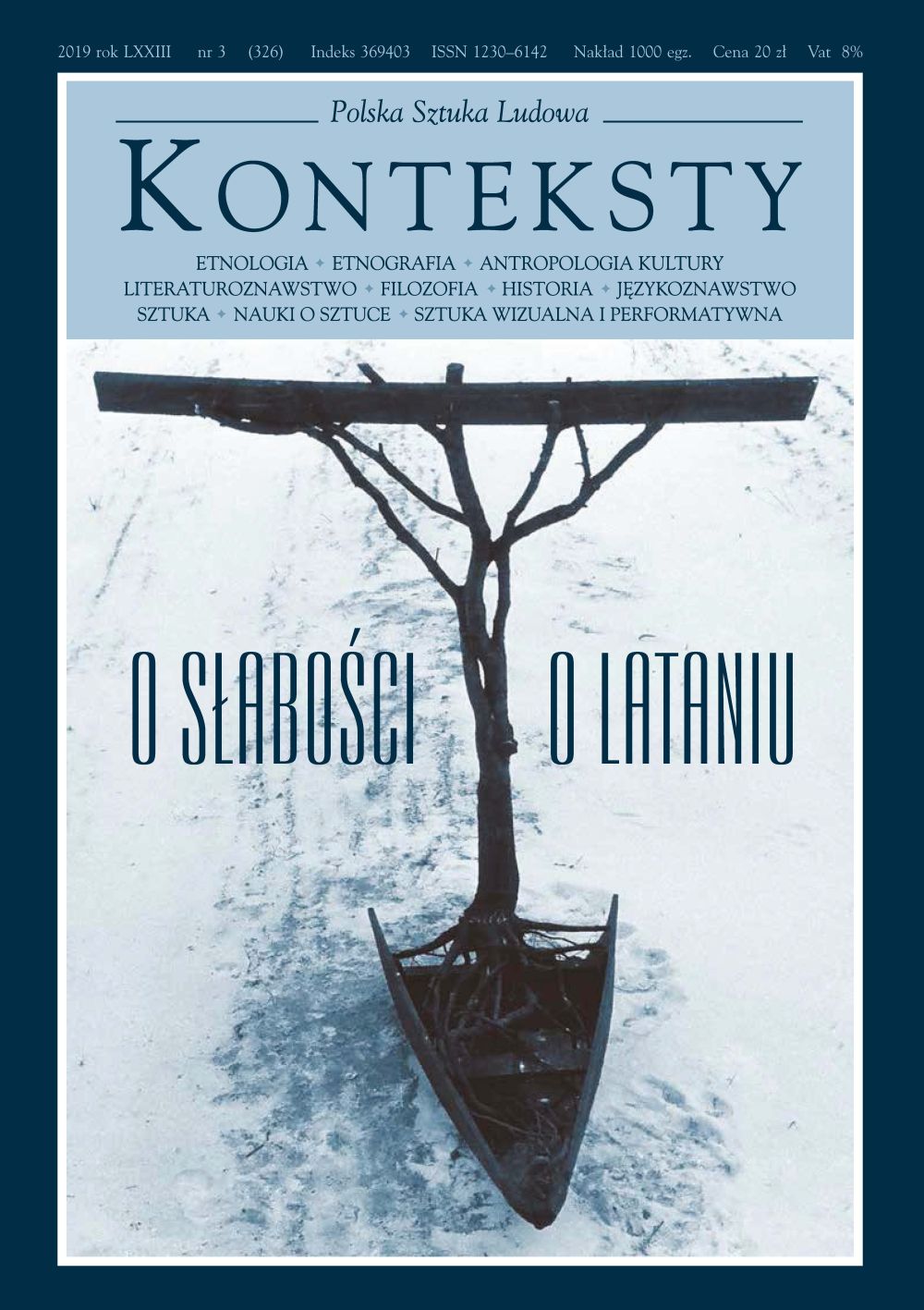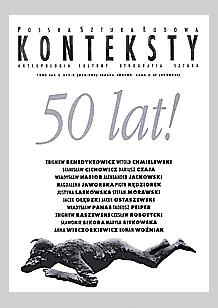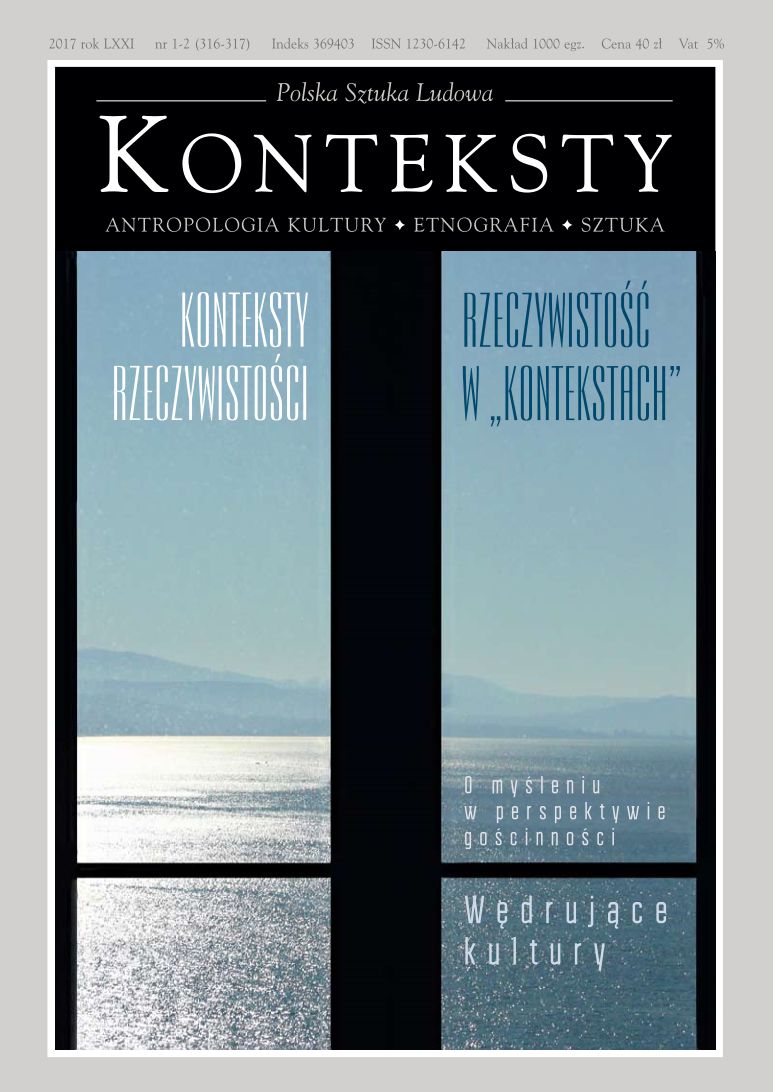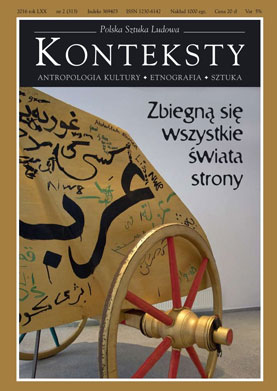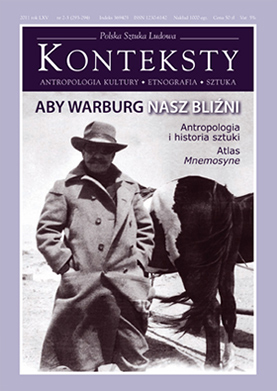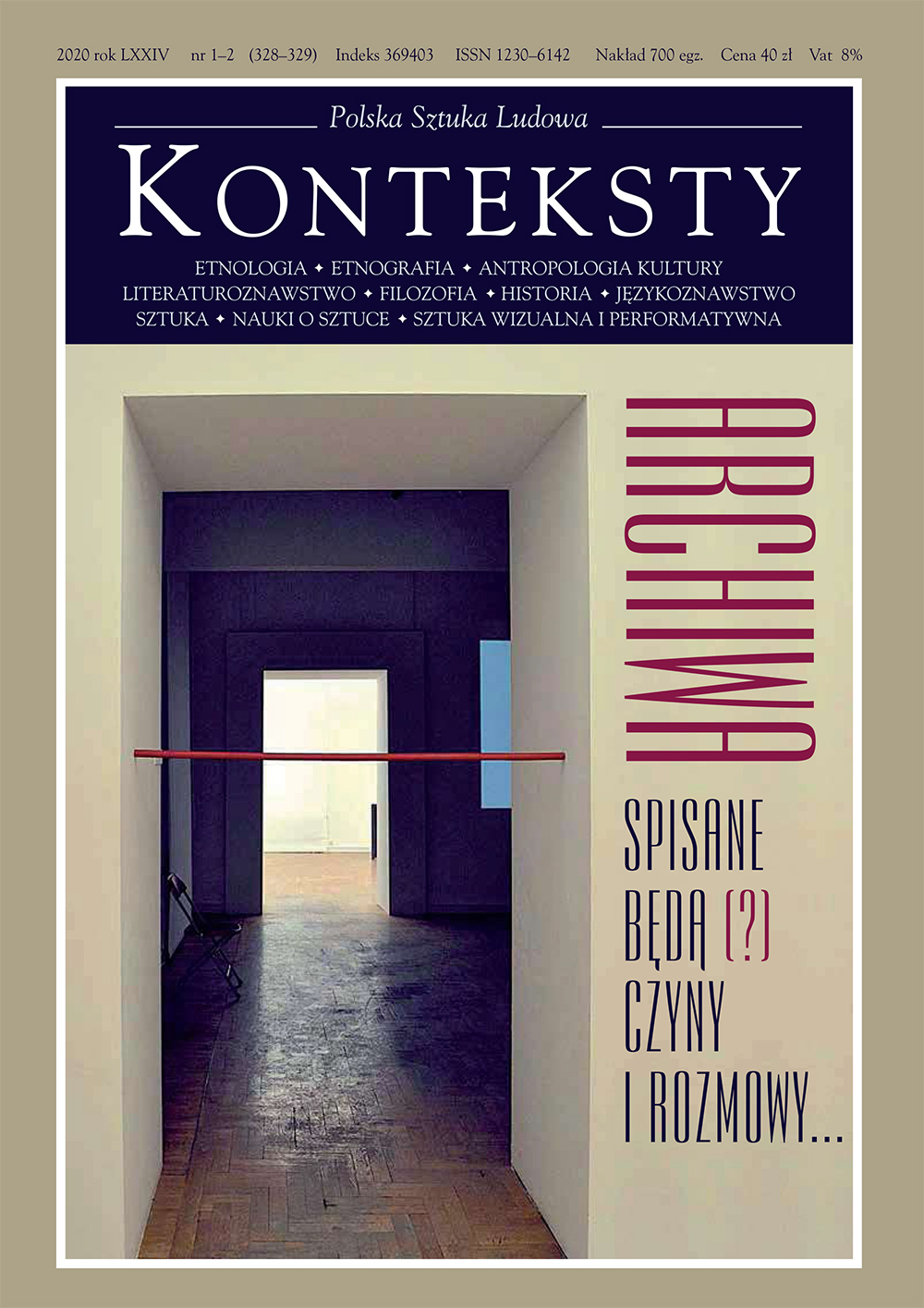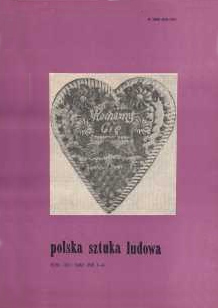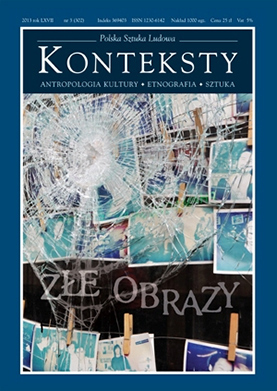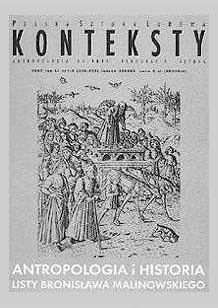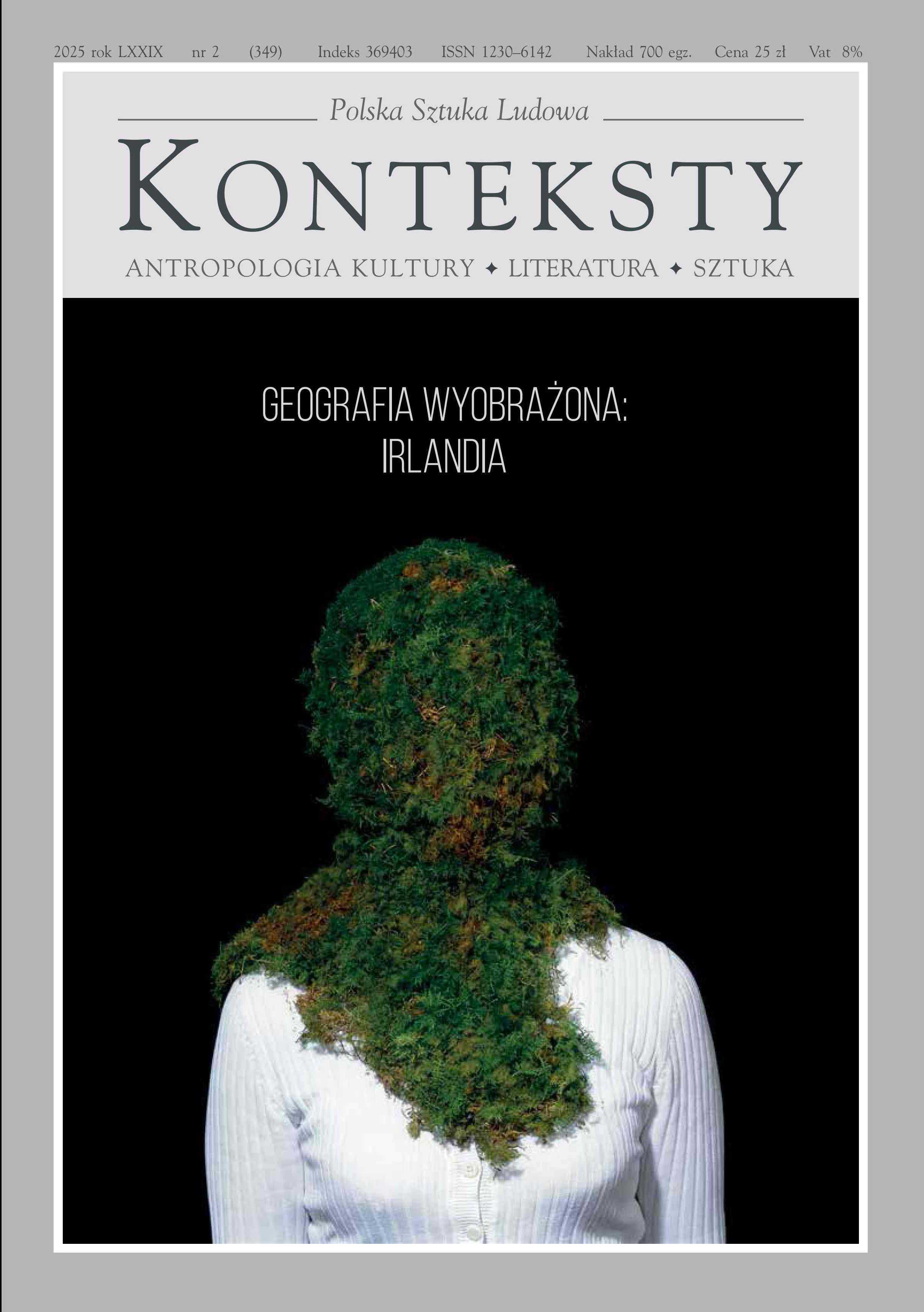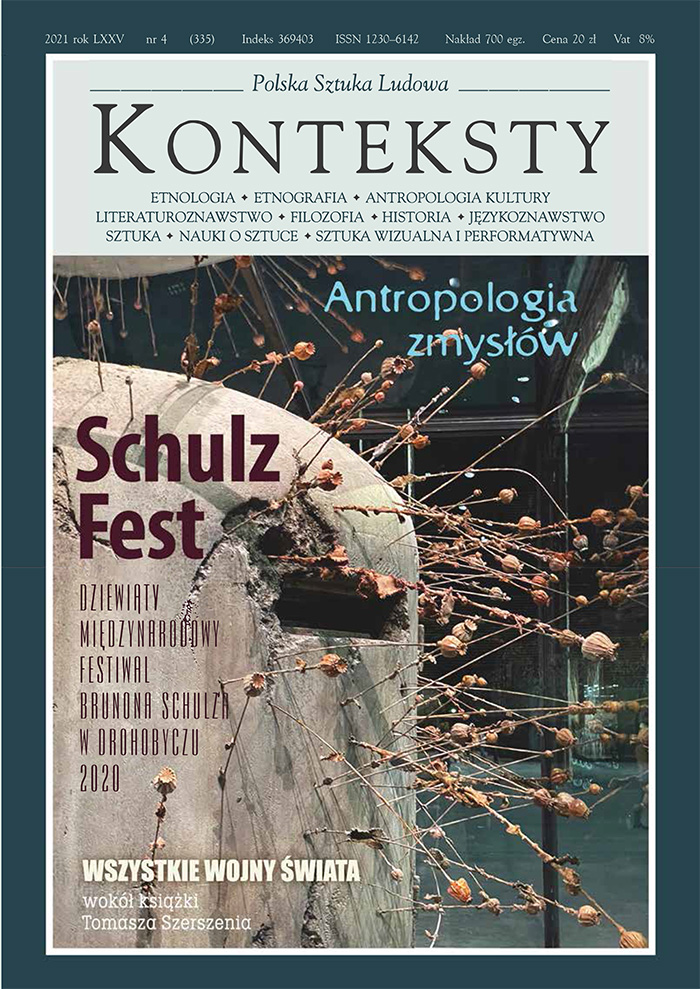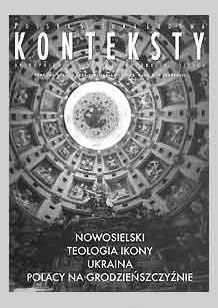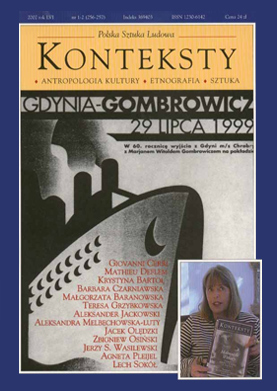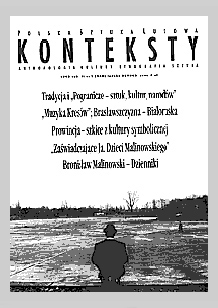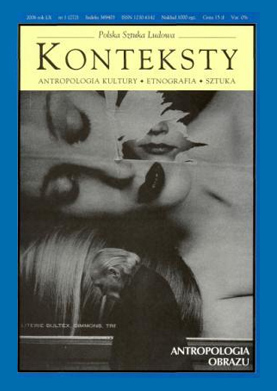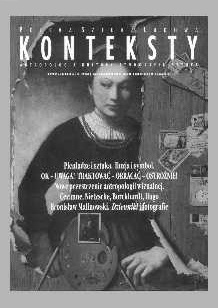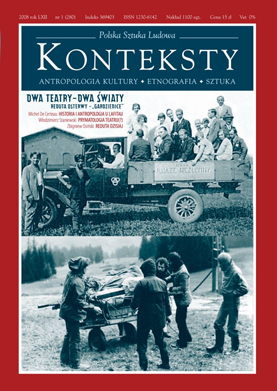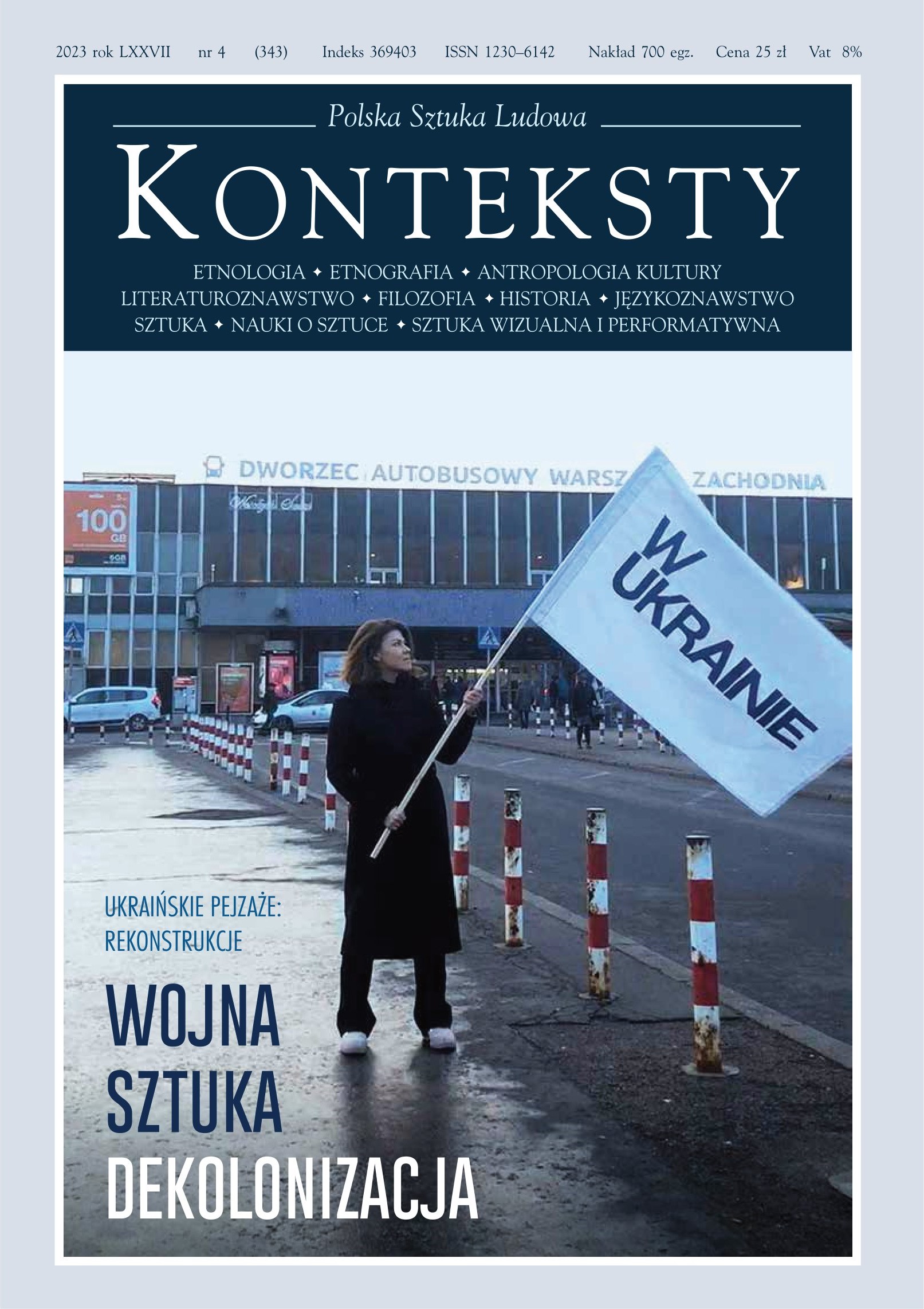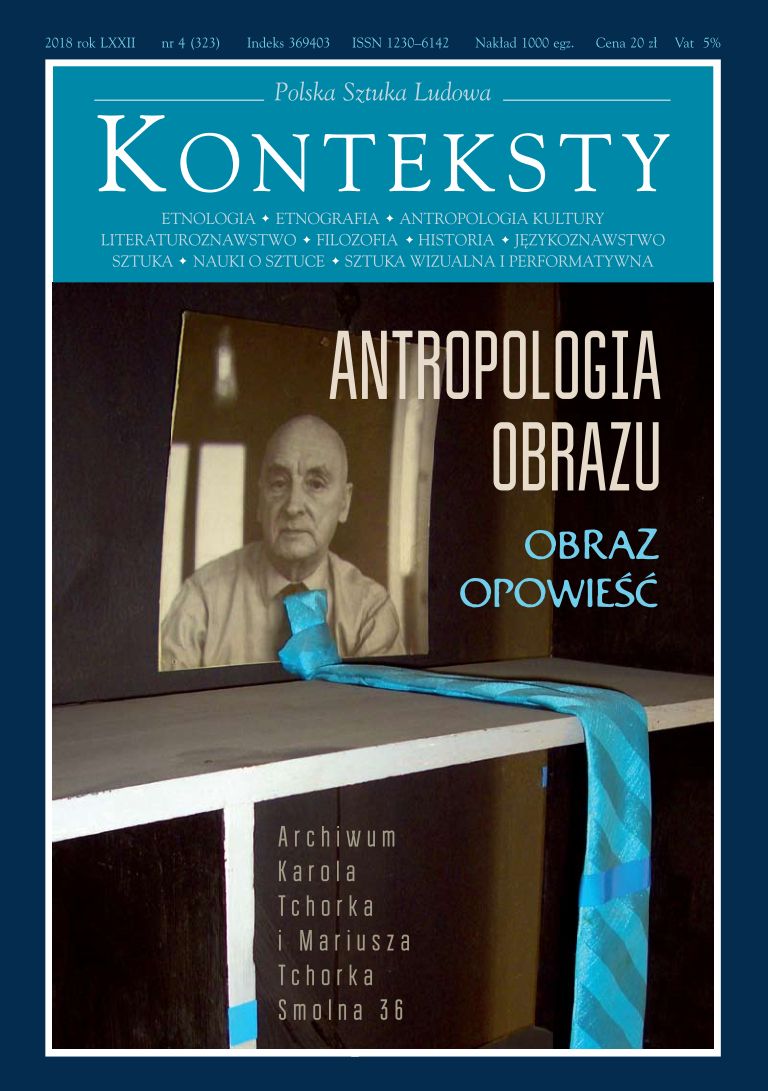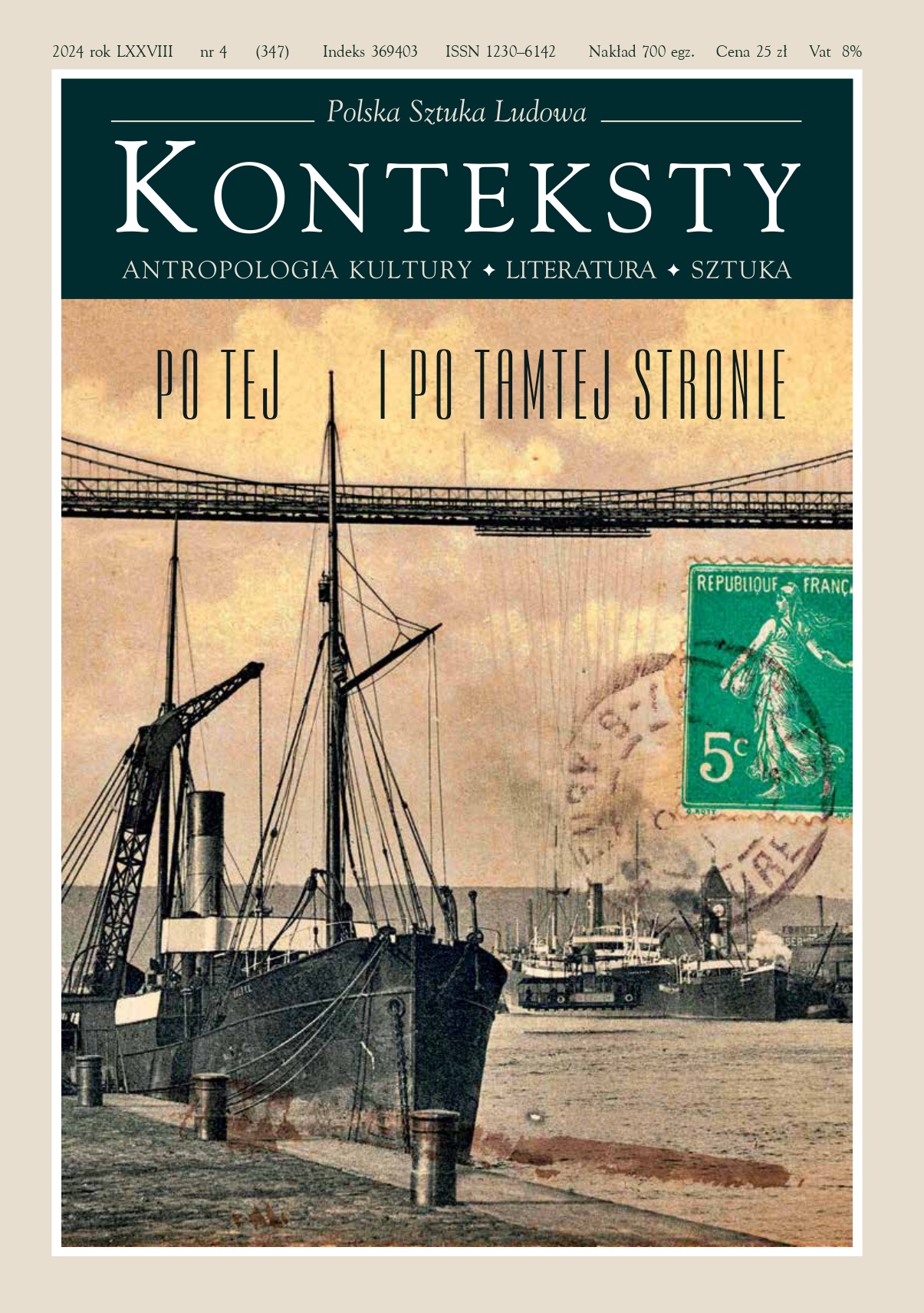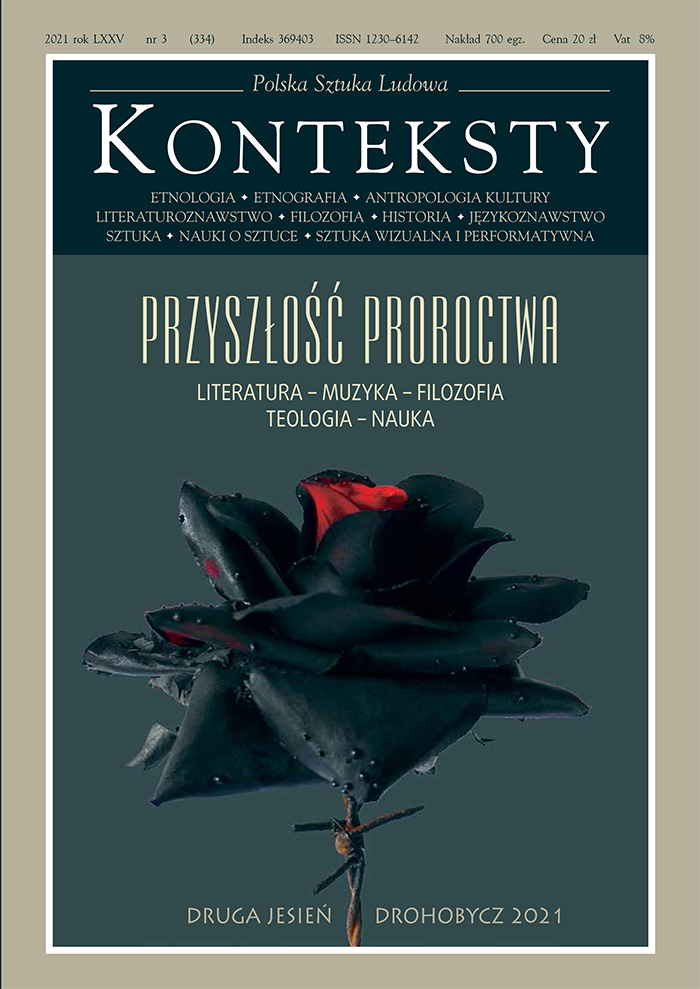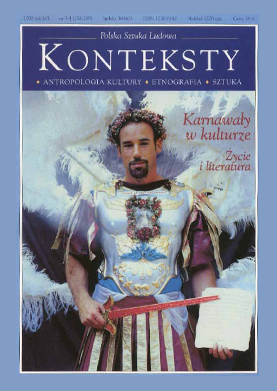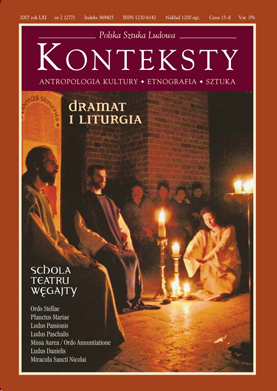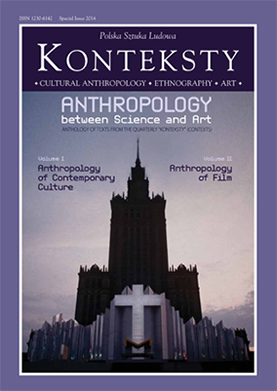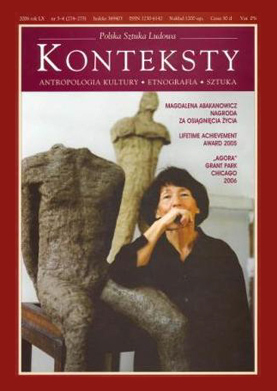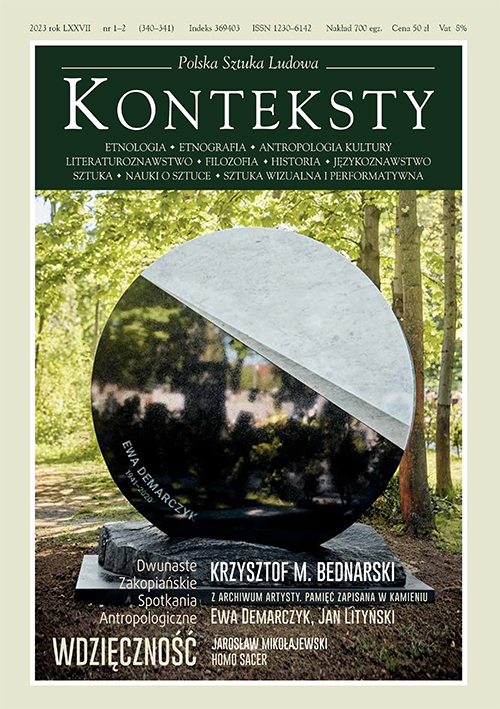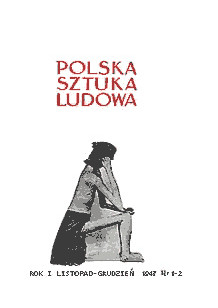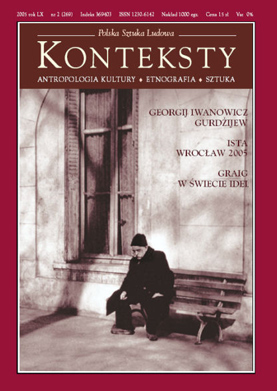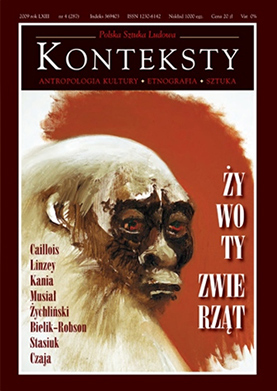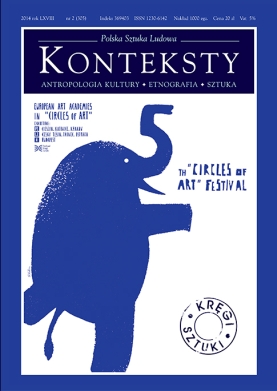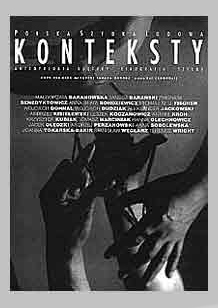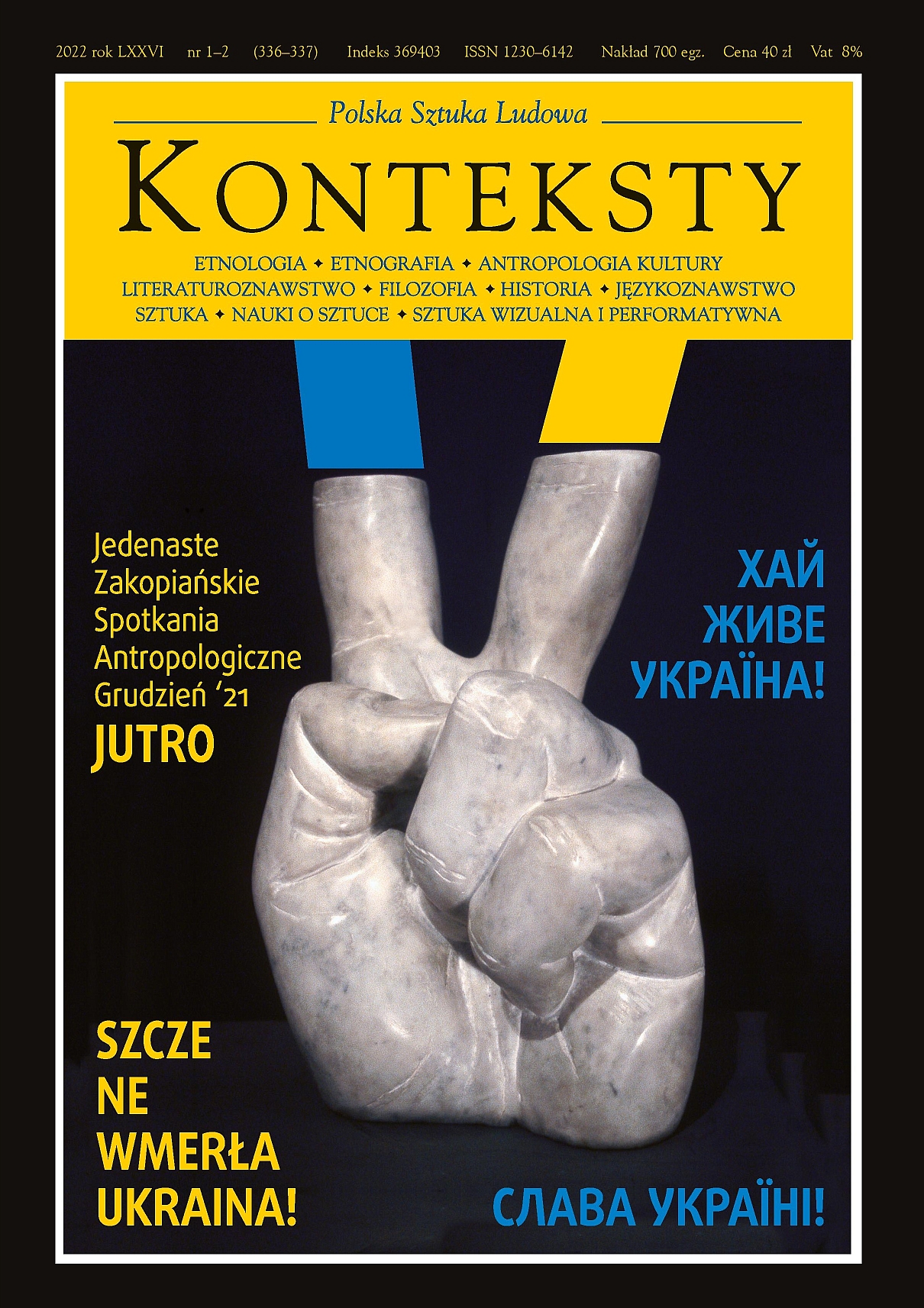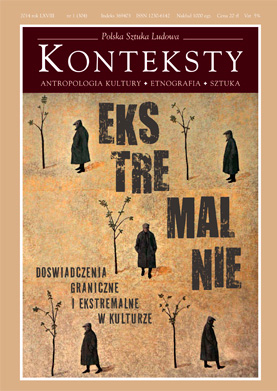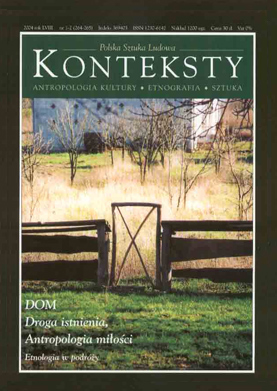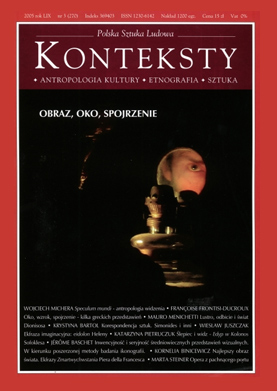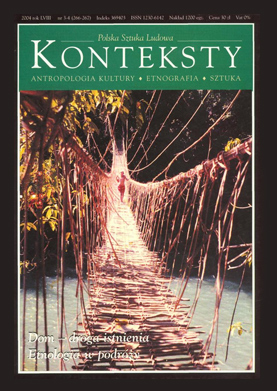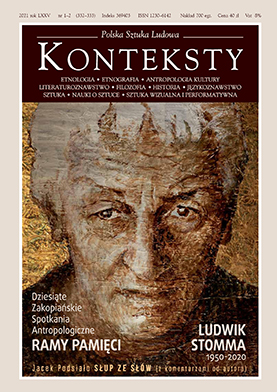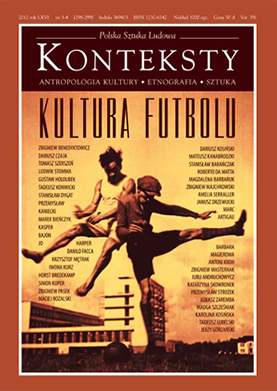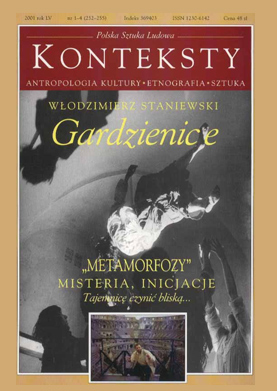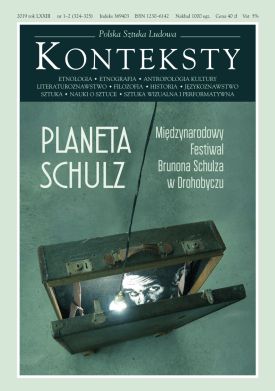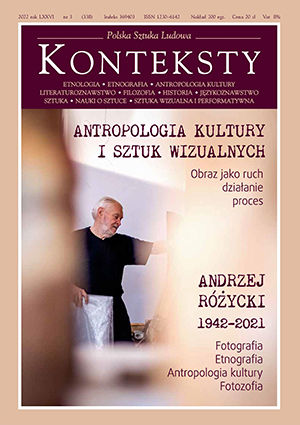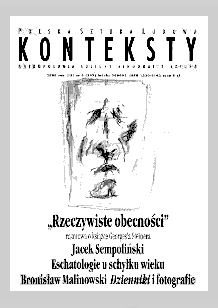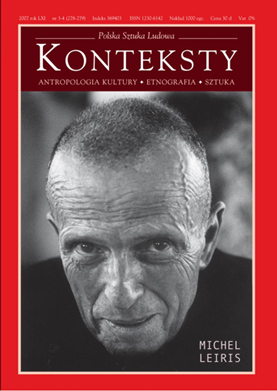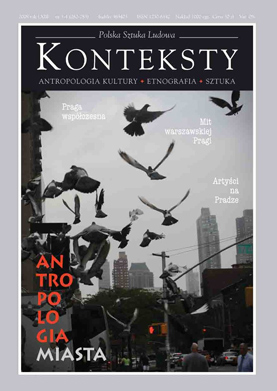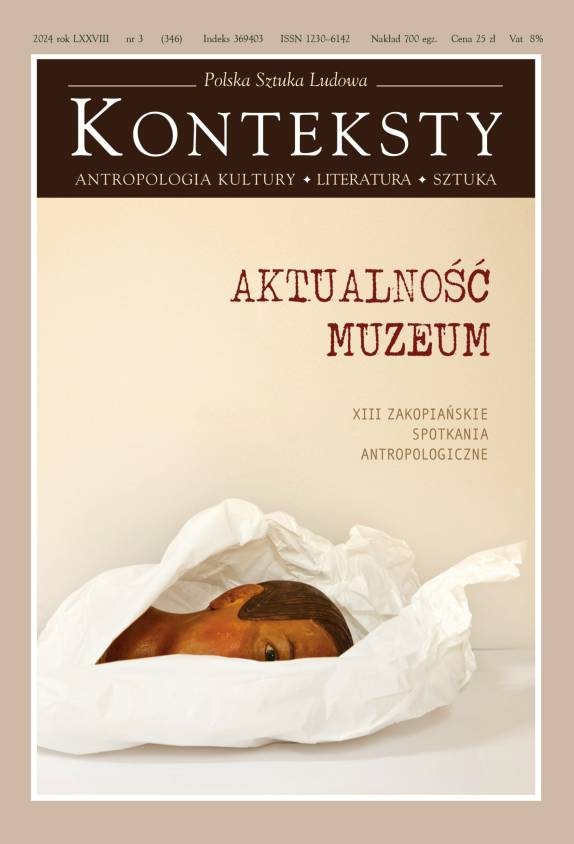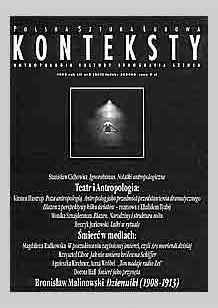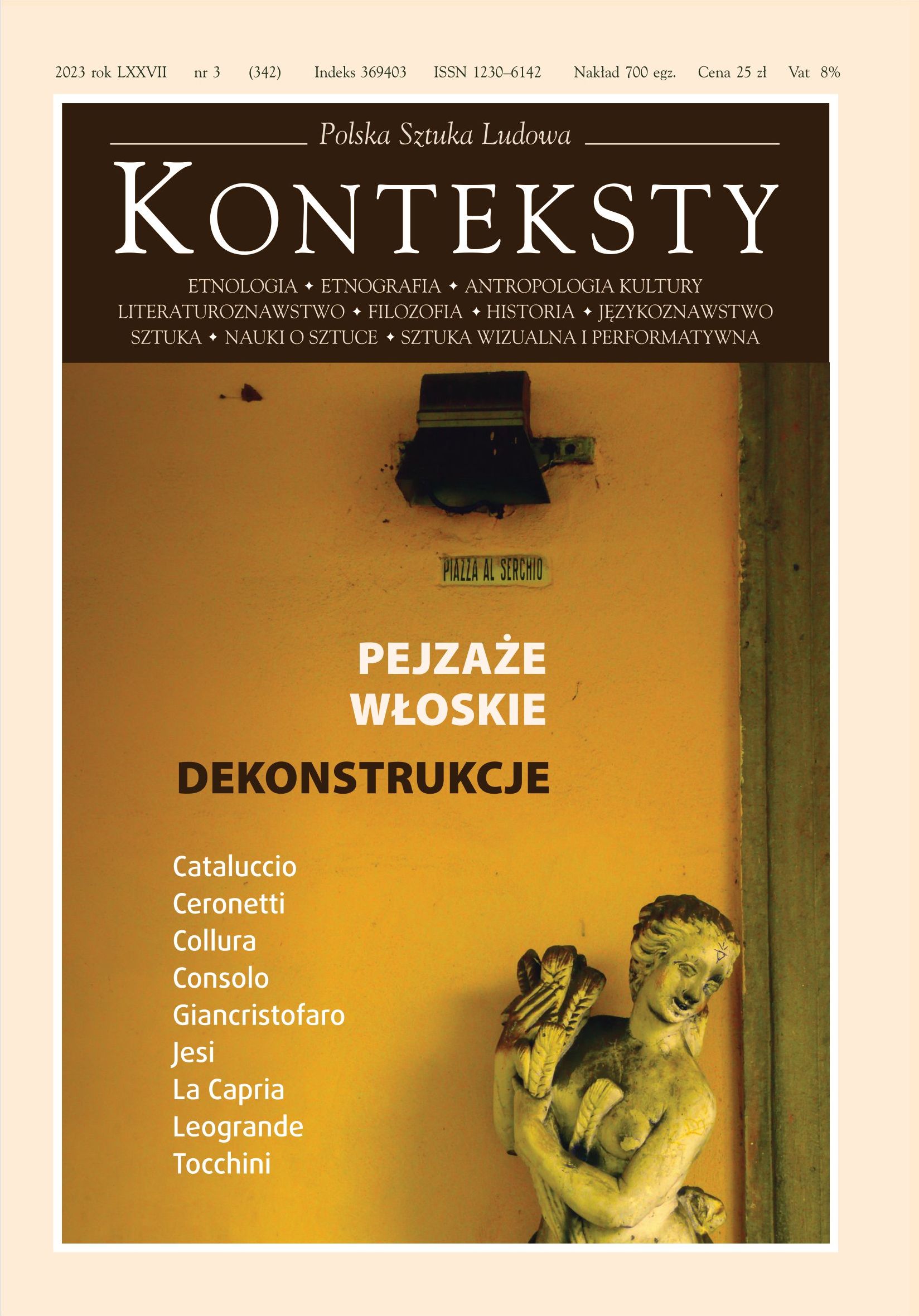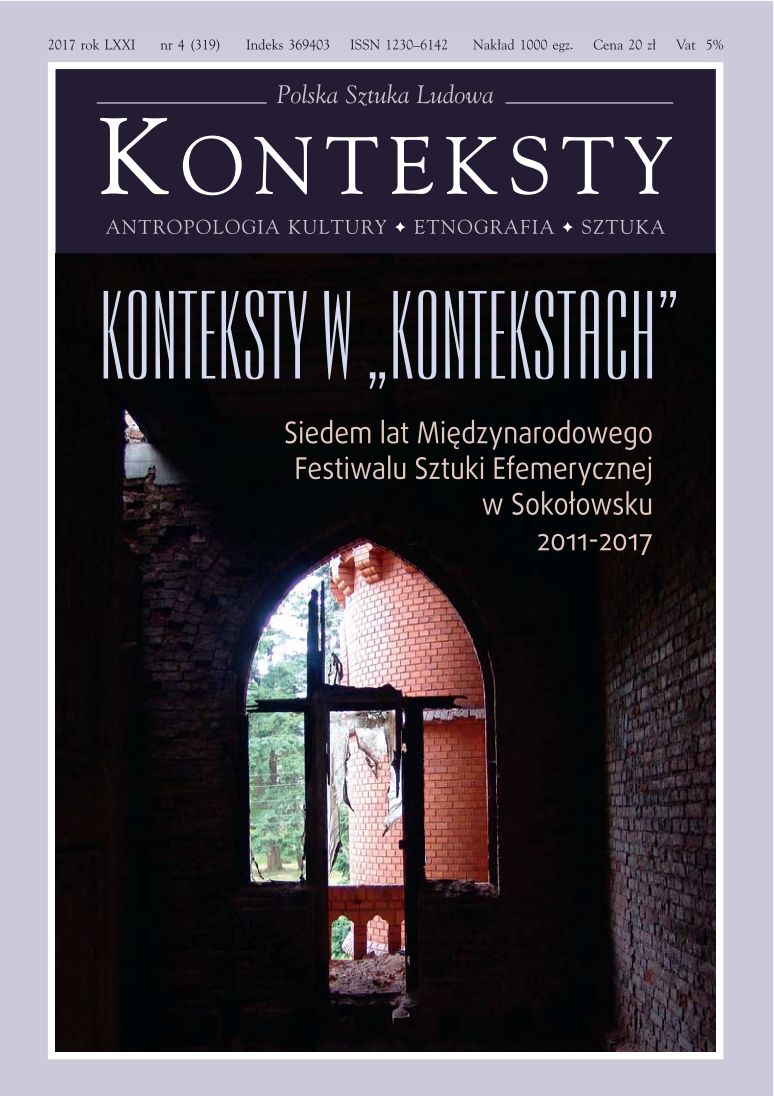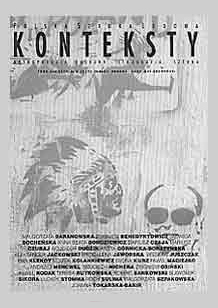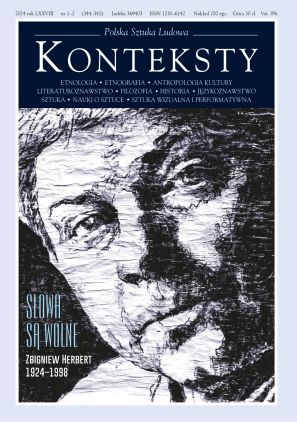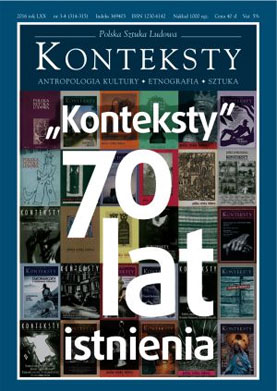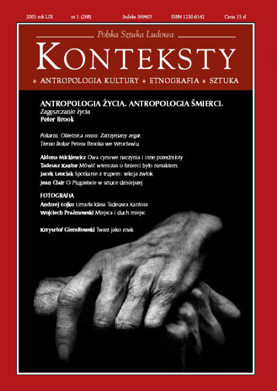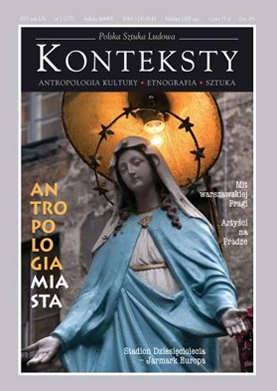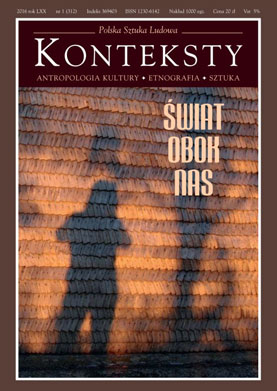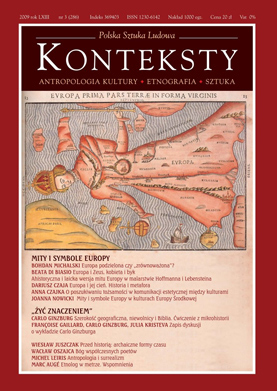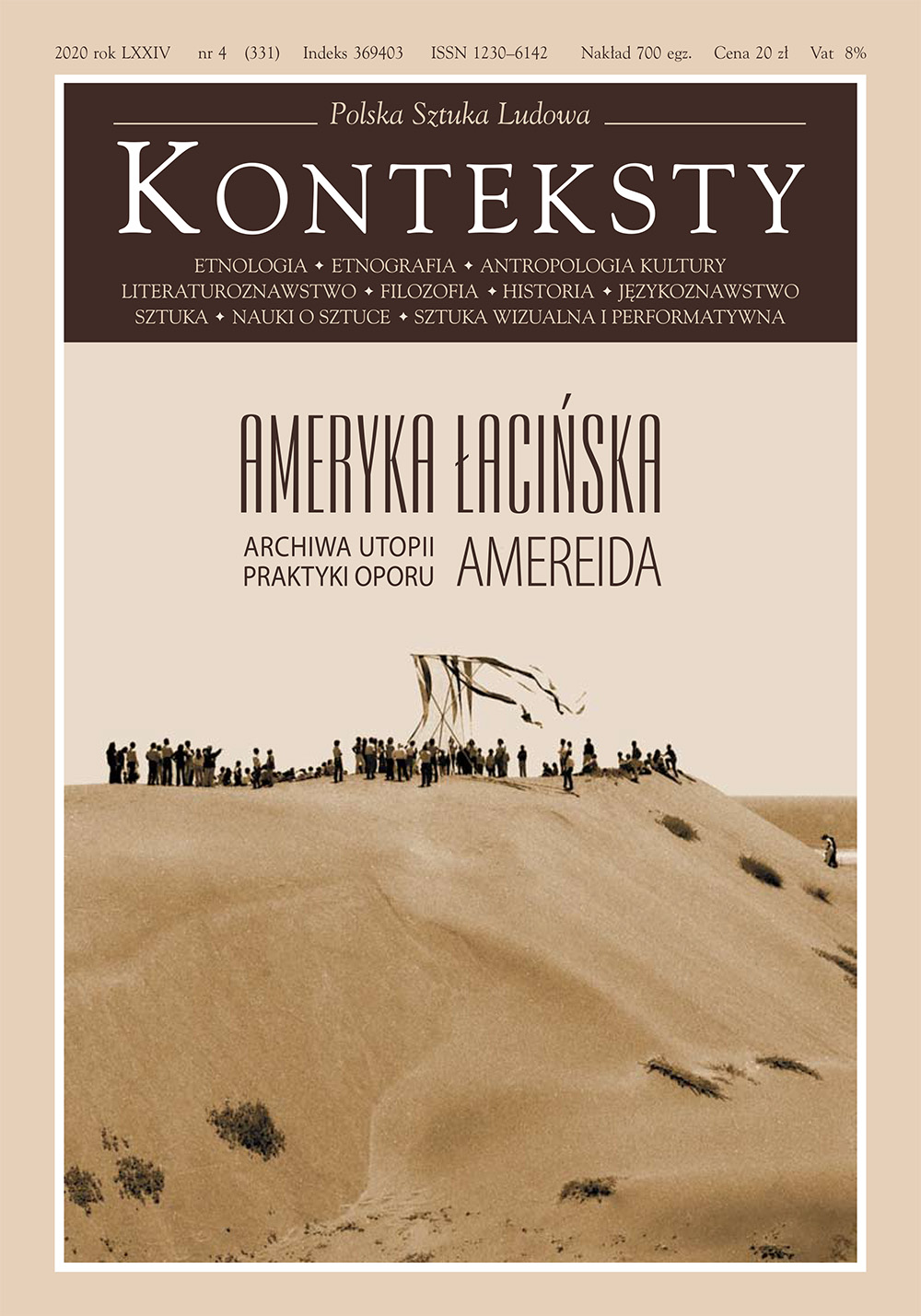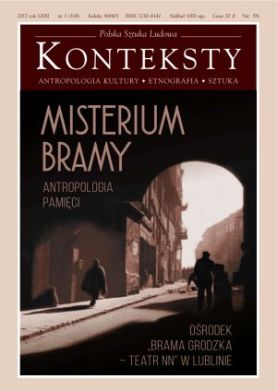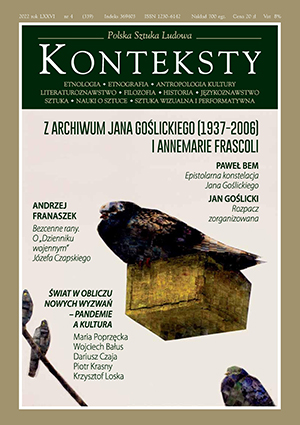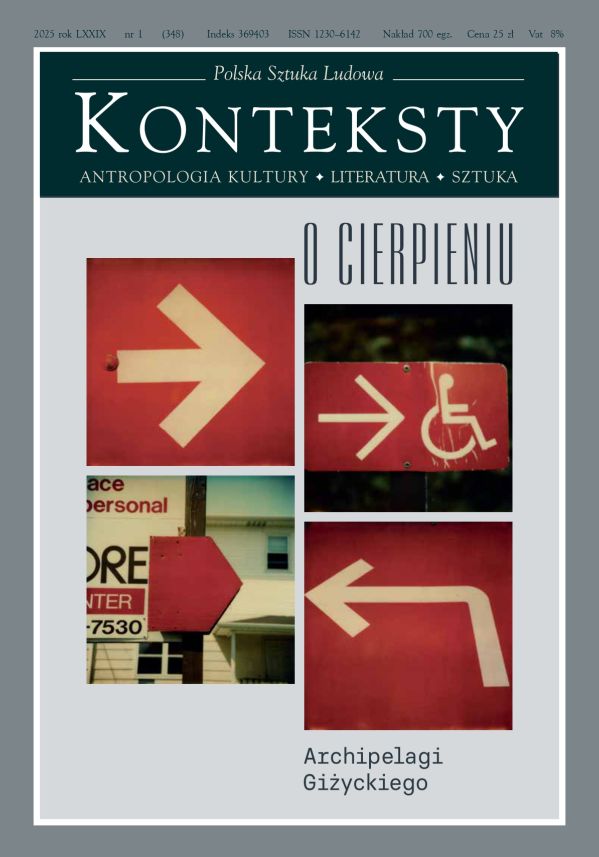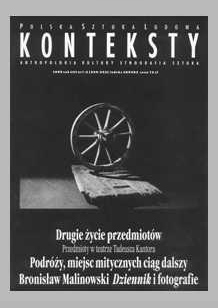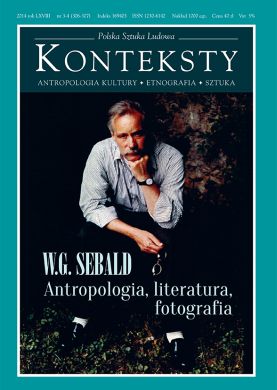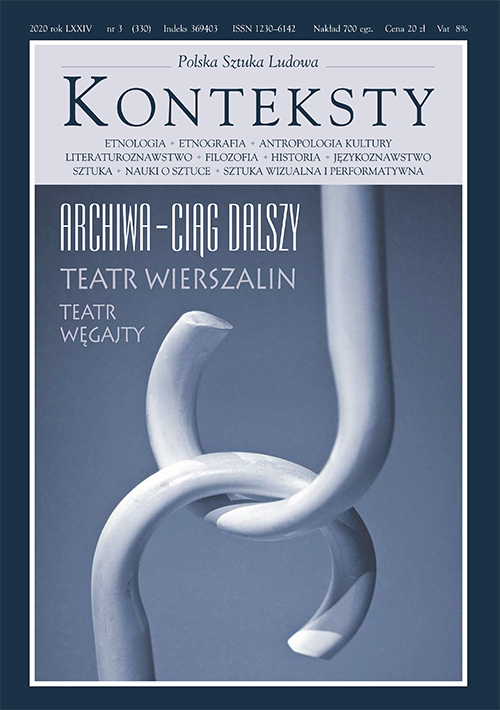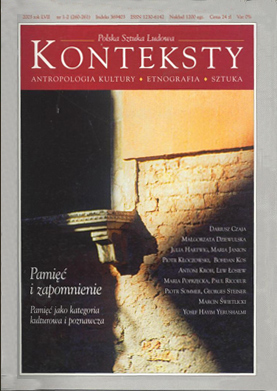Issue 2018/3 (322) - Anthropology of multicultural memory
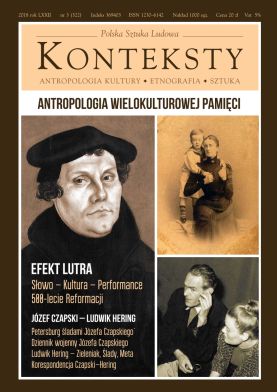
| Zbigniew Benedyktowicz | Introduction | 3 |
| Marcin Hintz | The Polish Context of the World Celebrations of 500 Years of the Reformation in 2017  | 4 |
The article presents the celebration of the 500th Jubilee of the Reformation in the Polish context. The attempt is the 500th anniversary of the Luther`s 95 Thesis published on 31st of October 1517. There are 3 protestant churches in Poland, which are direct successor of the Reform of the Church led by Luther, Melanchthon, Bugenhagen, Zwingli and Calvin in 16th century. | ||
| Piotr Sypczuk, Piotr Lasek, Andrzej Józef Baranowski | Sacral Architecture of the Evangelists against the Backdrop of the Progress of the Reformation in the Seventeenth and Eighteenth Century  | 12 |
A photographic exhibition: “Churches of the Reformation in the Lens of Piotr Drewniak” was opened on 5 December 2017 at the Institute of Art of the Polish Academy of Sciences to mark the 500th anniversary of the Reformation. The author of the photographs works at the institute of Art and in addition specializes in artistic and documentary photography. The exhibition featured selected objects of architecture and artworks associated with the emergence and progress of the Reformation in Saxony, Silesia, Prussia, Greater Poland, and the Grand Duchy of Lithuania. The exposition was accompanied by a scientific seminar about 500 years of the Reformation. The debates focused on the sacral architecture of reformed creeds - its transformations as well as mutual relations and impact. Among the former provinces of the Commonwealth the most conspicuous and longest-lasting Protestant character was maintained in Greater Poland. The earliest among the dissident communes were the Bohemian Brethren, whose monumental church was erected at the end of the sixteenth century in Krotoszyn. The second Protestant current was Lutheranism, which reached Greater Poland mainly from Saxony and Royal Prussia. The Protestant attitude towards church architecture differed from that of Catholicism. The architectural form was determined not by the symbolism of the building but by the components of serving God, predominantly the sermon. Greatest attention was paid to the uniformity of the interior, good acoustics, and visibility from all parts of the church so that members of the congregation could enjoy simultaneous contact with the altar, the pulpit, and the music choir. Martin Luther opened the first Protestant church at the Hertenfels ducal castle in Torgau already on 5 October 1544. The propaganda resonance of the Torgau church became the reason why it turned into a proptype of successive castle chapels in the Reich. Pioneering projects appeared the moment theoretical reflections started dealing with Protestant architecture (e.g. the church in Waltershausen, designed by Wolf Christoph Zorn von Plobsheim from Gotha or the realised projects of Georg Behr and his student Johann Georg Schmidt from the Dresden milieu). The confrontation of the Reformation and the Counter-Reformation did not produce a crisis in art. Both sides employed the most outstanding artists who executed works featuring common features and whose formal diversity still conceals assorted classification problems. | ||
| Marcin Hintz | Protestantism and Its Theology in the Face of Postmodern Challenges of the Twenty First Century  | 22 |
The article presents the relationship between the classical Protestant Theology and the Postmodern World. The attempt is the 500th anniversary of the Reformation in the year 2017. Protestant theology of the 16th century understood the human being as a Gods creature who is in permanent conflict with Satan. The anthropological formula of the Martin Luthers theology was framed in the Latin phrase simul iustus et peccator. In the Postmodern World such a description does not fit into the language and pattern of the majority of people who live in the digital reality. The article refers the ideas of Zygmunt Bauman (Liquidity) and Richard Rorty (Contingency) as protagonists of the postmodern philosophy as well as some of the pattern of the recent protestant conceptions. The conclusion of the article is that the Protestant theology should leave the older form of a big narration and tries to lead a real dialogue with postmodern human being. | ||
| The Luther Effect | ||
| Ryszard Koziołek, Marcin Trzęsiok | The Luther Effect | 29 |
| Theology | ||
| Marek Jerzy Uglorz | The Reformation is Not a Retouch, but a New Social Form  | 31 |
The Reformation was not a great or small evil. It also did not consist of setting the old order right but was the crowing of a centuries-long religious-social process, which created an entirely new social form. We repair something that is broken but which may still serve some sort of purpose. After being mended that particular reality continues to serve in its old form. A reformation is an entirely different activity. It repairs only indirectly and, first and foremost, grants society a new form. A reformation is needed in those cases when the old order can no longer be mended because it has developed into a cul de sac. Repair is based on the old form. The Reformation is a word-event that interprets the world anew and creates a new order. The Reformation was, is, and shall be a significant element of a religious-social process initiated by the Call of Abram, later the patriarch Abraham, whose spirit and idea were fulfilled by Jesus of Galilee. It is to this historical process that we owe man’s autonomy, emancipation, equal rights, and secularisation, conceived as a reversal from the sacrum of time and space towards the sacral nature of daily existence as man and interpersonal relations. This is the reason why the Reformation is not a completed process. It must go on although it will probably assume new shapes and be granted new names. Among the most characteristic outcomes of the Reformation is schooling and widely comprehended education. Evangelical Churches grant them supreme rank in order to render man free from prejudice and capable of being responsible for himself and his neighbour. Protestants are concerned with attaining a civic and creative society that does not expect but creates; does not react but acts; and is concerned with man being capable of making decisions independently not only within the sphere of the economy and politics but also of ethics, a man who does not have to be steered and does not hide behind the screen of Church authority or puts on the corset of the law. | ||
| Grzegorz Strzelczyk | What Did the Catholics Have to Tackle as a Result of / Thanks to Luther? Remarks on the Margin of the Resolutions of the Council of Trent  | 36 |
The Council of Trent is known in particular for its doctrinal resolutions. The gathered fathers, however, were engaged in reforming Church institutions, including essentially issues connected with the pastoral duties of the clergy and preparations suitable for their fulfilment. Within those resolutions the Council realized in practice part of the earlier postulates as well as those formulated at the time by previous critics of Church life. The thesis – which this article illustrates by resorting to examples taken from the Council texts – claiming that the Reformation contributed to a great measure to the emergence of Catholicism as we know it today appears to be justified. | ||
| Jacek Kempa | Reform and Ecumenism as a Spiritual State in Christianity  | 42 |
The contemporary climate of Catholic-Protestant relations is distinguished by ecumenical sensitivity and a readiness for reforms. Since that attitude is not the outcome of passing circumstances it is possible to indicate its justifications reaching deeply into the theological comprehension of the Church. This has been the topic of numerous and extensive studies. The presented text poses a question concerning the disclosure of the ecumenical nature of Christianity within the context of the declarations made by Luther and the history of their impact. The chosen single narrow path of activity is connected with the concept of communication, appreciated in contemporary theology. The beginnings of the Reformation can be perceived as a history of a dramatic severance of communication, and the ecumenical movement - as its reconstruction and development. | ||
| Jerzy Sojka | Teaching about the Two Regiments of Martin Luther – Theory and Praxis  | 47 |
A presentation of a key conception of the political ethics of Martin Luther – the so-called teaching about two regiments (kingdoms). The first part considers fundamental theoretical premises, indicating the division of the manner in which God rules in the spiritual domain (by the Annunciation of the Word) and the secular one (through the intermediary of established power). The second part specifies how Martin Luther applied this conception in praxis, as exemplified by his attitude towards the Peasant War, the Anabaptists, and the Jews. These examples illustrate a departure from a strict division into the secular and the spiritual for the sake of appealing to secular powers to wage a battle against those who err in view of the blasphemies propagated by them. The final, third part demonstrates the way in which contemporary Lutheranism reacts to this aspect of the Martin Luther legacy upon the example of a dispute conducted within the largest Lutheran organisation - the World Lutheran Federation – which, while disassociating itself from Luther’s attitude to Anabaptists and Jews, benefits from the distinction into two regiments in hermeneutic contexts and the involvement of the Church in the public sphere. | ||
| Grażyna Kubica-Heller | The Feminist Luther Effect, or on the Education of Silesian Evangelical Women – a Sketch from Historical Anthropology  | 55 |
An analysis of the impact exerted by the Reformation upon the situation of women in Cieszyn Silesia with particular attention paid to the realisation of the idea of universal education, which remained one of the most important questions in the teachings of Martin Luther. Universal education involved children of both genders. It remains unknown whether schools established at the time of the Reformation in every Evangelical church in Cieszyn Silesia actually taught girls, but traces confirming this assumption do exist. During the Counter-Reformation this process was halted by the Austrian state. Nonetheless, already from the early eighteenth century Protestant women from Cieszyn Silesia could benefit from education first at the only church school in that region permitted by the Austrian authorities and situated in Cieszyn, and then, from the end of the eighteenth century, in churches established across the whole country in the wake of the passage of the Patent of Toleration. Emphasis is placed on the cultural role played by the alumnae for associations of girls and women, first German and then Polish. Their example makes it possible to follow the phenomenon of German cultural hegemony and the emancipation of the indigenous population. The author also presented the first female students born in Cieszyn Silesia: Elżbieta, Kornelia, and Adela Buzek, studying at the Jagiellonian University, and Edith Demel, attending the University of Vienna, whose literary works permit an analysis of the women’s ”own voice”; this is by no means a solitary voice but a mixture of the voices of subjugation and privileged status. Its example also shows the prominent role played by women’s solidarity. Significantly, those female pioneers of higher education, who proved capable of breaking down barriers (institutional and cultural) blocking women’s access to universities, were Protestants. | ||
| Music | ||
| Marcin Trzęsiok | The Sense of the Infinite. Friedrich Schleiermacher and the Idea of Absolute Music  | 70 |
This essay presents analogies between the theology of Friedrich Schleiermacher, formulated in: On Religion (1799), and Romantic aesthetics of music represented mainly by Ernst Theodor Amadeus Hoffmann. The common denominator of those ideas is the conceit of infinity understood not speculatively but existentially. Hence the pressure placed both in theology and aesthetics on experience and intuition: hence also the acceptance of theological historiosophic schemes supplying arguments against conservative normative traditions. In this light the theology of the early Schleiermacher appears as a transition stage between Church religiosity and post-Enlightenment individual spirituality – a symptom of Taylor’s “expressivist turn”. Furthermore, upon the basis of the example of Thomas Mann’s Doctor Faustus the author attempted to outline the fate of the religion of the infinite in the course of the twentieth century. In accordance with a diagnosis contained in the presented book, the sense of infinity, although still vital, underwent in the twentieth century a basic mutation associated with a negative valorisation of exposing man to the endless and incomprehensible universe. This transformation manifests itself in the form of neo-gnostic intuitions. | ||
| Bartłomiej Barwinek | Theological Pessimism and the Philosophy of Conciliation. Heaven and Earth in Brahms’ Version of “Hyperion’s Song of Fate” by Friedrich Hölderlin  | 78 |
An attempt at a hermeneutic analysis of Schicksalslied op. 54 by Johannes Brahms to the words of the Song of Fate, contained in the second volume of Hyperion, an epistolary novel by Friedrich Hölderlin. The point of departure for the reconstruction of the principal idea of the work consists of the world outlooks of both authors, to a great measure stemming from Protestant tradition and remaining in various relations with the latter. The image of the world outlined in the Hölderlin poem, tainted with the tragedy of the ineffaceable isolation of suffering mankind from the joyous world of deities, is interpreted and uniquely questioned in Brahms’ work. This process is expressed in particular in the curious and exclusively instrumental coda of the composition, whose author presents his “philosophy of conciliation” between Heaven and Earth by purely musical means. With heretofore attempts at explaining the meaning of this finale made by, i.a. C. Floros and R. Taruskin, as his point of departure, the author suggested their revision. Its guarantee is an examination of the idea of Schicksalslied from the point of view of assorted proposals of deciphering the evolution of Hölderlin’s world outlook and poetic experience, contained in works by M. Blanchet, H. G. Gadamer, M. Heidegger, and P. de Man. The conclusion outlines the further philosophical development of Brahms, whose optimism slowly faded, as demonstrated in his later compositions. | ||
| Dorota Kozińska | Portrait of an Artist from the Time of a Crisis. On Matthias Grünewald and the Opera “Mathis der Maler” by Paul Hindemith  | 88 |
Matthias Grünewald, author of the Isenheim altar, one of the greatest masterpieces of Gothic-Renaissance art, is regarded as a precursor of Modernistic Expressionism. The Grünewald legend was revived at the end of the nineteenth century and flourished all the way to the turn of the 1920s when the altar drew the attention of luminaries of New Reality (Neue Sachlichkeit). It also attracted the interest of Paul Hindemith, leader of the young generation of the German avant-garde. His work on the opera Mathis der Maler, referring to the life and time of the German painter, was pursued in a similarly turbulent atmosphere and produced equally dramatic consequences as Grünewald’s years-long efforts connected with the creation of the altar in the Antonine church. Both authors worked at a time of a crisis: Grünewald in a period of the reforms launched by Martin Luther and the bloody events of the Peasant War, and Hindemith in the wake of the fall of the Weimar Republic and under the growing pressure of the cultural policy of the Third Reich. The author of this sketch endeavoured to explain why Hindemith chose precisely Matthias Grünewald, and the manner in which he conceived his opera as a manifesto of non-conformism and the freedom of an artist - predominantly one who is doomed to function in an extremely unfavourable socio-political context. | ||
| Zbigniew Pasek | The Funebral Culture of Protestantism. On the Consolation Offered by Protestant Songs about Death  | 91 |
This is a reconstruction of the specificity of Protestant spirituality by means of a comparative analysis of Protestant and Catholic funeral songs. The text focuses on such characteristic features as, e.g. the certitude of salvation or the symbolism of the return to “the house of the Father”. Catholic songs, marked with humanistic sorrow, reject this sort of certainty but a vision of the further fate of the soul after death, firmly founded in Christology, made it possible for the Protestants to create a different funebral culture decipherable from the texts of songs performed at funerals. | ||
| Philosophy | ||
| Agata Bielik-Robson | From Nature to History: the Luther Effect in the Case of Hegel  | 97 |
The title of this essay refers to the “from Nature to history” transition, which defined the modern epoch and was rendered possible by the theology of the Reformation. It is the latter that undermined the principles of the holy natural law formulated by Thomist metaphysics and invested in work on Nature by subjecting it to a great historical transformation. In turn, the sub-title of the essay – “The Luther Effect in the Case of Hegel” – has been granted both a wider and a narrower interpretation. The former refers to the general effect of the Reformation within Hegelian philosophy which, as the author assured us, would have not come into being had it not been for the spiritual fomentation of ”Germanic Christianity”. The latter refers to the concrete effect of Lutheran thought in the form of the most important Hegelian conceit, namely, the category of labour. Hegel, who always regarded himself as an Orthodox Lutheran, is the author of reflections that to a considerable extent differ from the dogmas of the Augsburg confession; nonetheless, in a single aspect he remained loyal to the conception launched by Martin Luther, i.e. the idea of labour as simultaneously a profession and a calling: Beruf as Berufung. | ||
| Michał Warchala | The Luther Effect, the Weber Effect. Rationality, Religion, and the Spirits of Capitalism  | 105 |
The article refers to the famous thesis formulated by Max Weber about the relation between the Reformation and the capitalist work ethos, contained in the book: The Protestant Ethic and the Spirit of Capitalism as well as the dispute conducted by Weber and Werner Sombart. Sombart, a scholar today basically forgotten, is actually an interesting precursor of Weber’s numerous arguments and theoretical solutions. The discussion held by the two men turns out to be a fascinating and erudite dispute about the impact of the Reformation, or, more extensively, Christian spirituality upon one of the key elements of the modern age, i.e. rationalised Western capitalism. | ||
| Rafał Biskup | “Have Your Forgotten the Words: God Watches Over Us!”? The Fate of Tyrolean Protestants in “Die Zillertaler”, a Novel by Fedor Sommer  | 113 |
The fate of the Tyroleans who settled down at the foot of the Karkonosze Mts. (mainly in Mysłakowice and Sosnówka), and who in 1837 were compelled to leave their homeland as a consequence of the Confession Decree issued by the Habsburgs, is an essential example of Silesian cultural and religious legacy. It is also an example of the continuation of the idea of Prussian religious tolerance initiated already during the seventeenth century in the aftermath of an extremely turbulent period of religious wars, the most prominent being the Thirty Years’ War (1618–1648). This article discusses the novel: Die Zillertaler by Fedor Sommer, dedicated to this theme, and is composed of three parts: a portrayal of the historical backdrop connected with the emigration of Tyrolean Protestants; a portrayal of Protestantism in the novel; and a presentation of, and commentary on a review written by Max Koch in 1925. | ||
| Alina Mitek-Dziemba | The Tölpel Effect? Environmental and Eco-theological Reflection in Contemporary Protestantism  | 122 |
With the problem of the long-term consequences of the activity of Martin Luther as its point of departure the article wishes to consider them in relation to the manner in which contemporary eco-theological visions developed and the sort of reflections they originated from by asking whether Protestantism and the religious ideas of the Reformation exerted a fundamental impact upon their shaping and if so then why does the natural-environment-oriented ethics find a more conducive base in this type of religiosity. Is the original attitude of Martin Luther significant in this case (including reflections on the eschatological fate of his beloved dog Tölpel)? What essentially would the long-term effect of the Reformation change of thought consist of? First, it produced, as is often stressed, a Weberian disenchantment of the world and the flourishing of modern capitalism so as to subsequently, in the late modern age, bring an inner critique of that process as well as the appearance of more responsible attitudes towards Nature and beings other than man. In order to reply to this question the author analysed works by Martin Luther from the viewpoint of their eco-theological contents, and then considered the progress of religiously motivated environmental ethics within contemporary Protestantism by examining its returns to the thought of Martin Luther, and in particular to reading the Bible, proposed by the German reformer, in a reference to the relation between God, man, and creature, the manner in which it comes into being in a world of primary harmony, in the light of the subsequent fall, and in the perspective of future salvation. | ||
| Damian Guzek | Traces of Mediatisation in the Case of Martin Luther  | 133 |
The article deals with the sources of mediatisation in the activity of Martin Luther, with the author asking whether the phenomenon of mediatisation should be derived from Luther. D. Guzek started with the basic difference between mediation and mediatisation and went on to reflect on the connections between mediatisation and the thought and activity of the Reformer by taking into consideration three perspectives: institutional, cultural, and material. Consequently, he indicated the characteristic features of mediatisation, whose sources are unambiguously connected with the onset of the Reformation. | ||
| Literature | ||
| Tadeusz Zatorski | The Unintentional Revolutionary. Luther as Seen by Heine  | 138 |
A presentation of the way in which Heinrich Heine portrayed Luther in his essay: On the History of Religion and Philosophy in Germany. Heine envisaged Luther as a person who brought the Germans freedom of thought, which in turn produced a philosophy that critically studies also Christianity. Another consequence of the Reformation was theology critical of traditional dogmas and leading to an actual self-dissolution of Christian religion, which in Germany was gradually replaced by pantheism. Naturally, all those phenomena contradicted the actual intentions of the Reformer, who became a “revolutionary” entirely “against his will”. | ||
| Ryszard Koziołek | How Does One Reform with a Hammer?  | 147 |
This essay is about the emblematic tool of the Reformation, i.e. the hammer, which Martin Luther supposedly used in late autumn 1517 for nailing his 95 anti-indulgence theses onto the door of the Castle church in Wittenberg. Or rather about the absence of such a tool whose use is unconfirmed by every researcher dealing with the history of the Reformation. This absence gives rise to the actual question posed by such reflections: what is the significance of the new hermeneutics of the Bible, devised by Luther, for the present-day expert on literature? | ||
| Aleksander Nawarecki | Reading the Psalms together with Luther  | 154 |
A text dedicated to comments on the Psalms by Martin Luther, whose rank is testified by the fact that in Luther’s biography the onset of Reformation undertakings (1517) coincides with the presentation, interpretation, translation, and publication of the Psalms, to which historians pay insufficient attention. A symptomatic fact from this period is the accepted pseudonym (Eleutheros) and the change of the surname Luder to Luther, motivated by the symbolic presence of the letters/sound “the”. The author drew attention to the similarity of the new names with the word: Lautherist (lute player) and its source: Lauthe (lute). Martin Luther, who did play the lute, assumed the part of David, and did so at a time when in Germany the fashionable lute replaced the archaic psaltery (from which psalms took their name). The Polish reader knows little about this since among the texts of Psalms by the Reformer (the contents of five volumes in the American edition of his works), only the second Preface to the Psalter (1528) was translated into the Polish, and several remarks on this topic appeared in an introduction to the Catholic version of the Psalms (1988, Polish translation 2007) by G. Ravasi. The Polish reader may thus reach - out of sheer necessity – for Reading the Psalms with Luther (1993), i.e. Luther’s version of the Psalms, today the most popular in the world. This psalter is a compilation of assorted texts by Luther, based on Summarien über die Psalmen (1531–1533). A set of 150 brief comments indicates in each Psalm the presence of five fundamental functions (1. Prophecy; 2. Teaching; 3. Consolation; 4. Prayer; 5. Thanksgiving) together with references to the Ten Commandments and seven calls in the Our Father prayer. Luther demonstrated in a “summarizing” way that the Psalms are a “Small Bible” condensing the diversity of the Old and New Testament; at the same time he devised a poetic of counting the “functions” inscribed into the holy text. In this way he appears as a protagonist of a functional and structural analysis of the text, which directly inspired V. Propp (Morphology of the Tale) and indirectly – masters of narrative grammar: C. Levi-Strauss, R. Barthes, A. Greimas, and T. Todorov. | ||
| Adam Regiewicz | Can Reading be Protestant?  | 162 |
It is impossible to conceive the contemporary manner of reading without Luther and his theses. The postulate of individual reading (sola scriptura), which proved to be important for the development of literature, is a cornerstone not only for hermeneutics as a whole but also for modern post-structural interpretation-oriented thought. It alters the very praxis of reading (silent, visual, analytical, ordinary) and the manner in which it is present in the cultural circuit (e.g. resignation from the canon for the sake of separated reading). The appearance of Lutheranism was accompanied by a comprehension of reading as an “event” and an existential experience, which renders it a dialogical act. | ||
| Joanna Soćko | Did Men Write the Bible Only for Boys? American Echoes of the Voice of Luther in a Poem by Emily Dickinson  | 168 |
The article is based on an interpretation of a single poem by Emily Dickenson, up to now not translated into the Polish; this is poem no. 1545 starting with the verse: The Bible is an Antique Volume. By sketching the biographical context, which affected the shape of the poem in question, the author demonstrated how the teachings of Luther and Calvin impacted Puritan communities in the United States and the developing parallel identity narrations of the Americans. In her comments on particular verses of the poem the author discussed, i.a. the specificity and role of Puritan preaching, the influence of Protestantism on the attitudes and arguments of nineteenth-century suffragettes, and the Puritan obsession with death. The last part of the article indicates the way in which Puritan legacy affected the visionary idiom of the pioneering poetry of Emily Dickinson. | ||
| Piotr Bogalecki | The Bonhoeffer Effect in Polish Poetry from Barańczak to Różewicz  | 177 |
An article on the impact exerted on Polish poets by the biography and theological intuitions of the Wrocław-born Dietrich Bonhoeffer (1906–1945). While stressing the role played by publications from 1970 (Selected Writings by the Lutheran theologian and the monograph: Chrześcijanin w Trzeciej Rzeszy by Anna Morawska) Piotr Bogalecki perceived this problem as a symptom of the already described influence of this author on the opposition of the 1970s and 1980s, especially the so-called secular leftists. Here, research material is composed both of discursive texts by Polish poets referring to Bonheoffer (S. Barańczak, W. Woroszylski or A. Zagajewski) and essayists evoking them (A. Michnik or S. Chwin), as well as poetry i (i.a. S. Stabro, W. Woroszylski, K. Brakoniecki). Longer analyses are dedicated to the Sztuczne oddychanie (Artifical Respiration) cycle by Barańczak (1974), in which the author, following the example of J. Kandziora, discovered numerous mentions of Bonhoeffer, as well as to the poem: nauka chodzenia (Learning to Walk) by Tadeusz Różewicz (2004) with its outright direct references. A lateral objective of the article is a survey of post-war Polish poems evoking the person of Martin Luther, some of which – such as texts by Różewicz or Woroszylski – were written at a time when their authors were interested in Bonhoeffer. | ||
| Dariusz Czaja | The Apocalyptic Thorn. Różewicz’s Apophases  | 185 |
In his disturbing poem: nauka chodzenia (Learning to Walk) Tadeusz Różewicz declared: “In the last two years I take lessons / from Pastor Dietrich Bonhoeffer”. Seen from the level of banal phrases about the poet’s world outlook this declaration must sound rather surprising. An author regarded as the “on call” atheist of Polish poetry, a writer proclaimed as a nihilist and a prophet of nullity, now, rather unexpectedly, turns towards the teachings of an Evangelical pastor. This gesture - at first glance perhaps unclear, doubtful, and self-negating -– can be, however, understood once we begin to dig deeper beneath conventional banalities. In a word: I propose the thesis that the Różewicz oeuvre, in particular its later part, gravitates towards a certain form of poetic theology (in an extremely unorthodox version!) and that the person of the Protestant Bonheoffer is a discernible trace of that turn. Quite possibly it is not the sole trace but sufficiently conspicuous to make following it worthwhile. | ||
| Ireneusz Gielata | The Loins of the Goddess Venus – on the 96th Thesis by Martin Luther  | 192 |
A presentation of a teaching of Protestantism according to Heinrich Heine, contained in the essays: The Romantic School (1833-1835) and The History of Religion and Philosophy in Germany. The Martin Luther 95 theses became a sui generis “theological mine” (H. Schelling), whose explosion contributed to, i.a. the removal of paintings from Protestant churches and replacing them with “a musical canvas” - the religious cantata. In the dispute about the sale of indulgences Henrich Heine sought the signs of a wider process: the battle waged by Christian spiritualism against pagan sensualism, proving that this conflict was also reflected by Renaissance painting, which he defined as Protestantism of sorts while recognising “the loins of Venus” executed by Titian to be a successive thesis by Luther. Heine identified the “spirit of Protestantism” with freedom, and this compelled him to perceive Renaissance art as a process of emancipation from the yoke of Catholic spiritualism. | ||
| Hans Joas, Ireneusz Piekarski, Łukasz Tischner | Belief in a World of Options | 198 |
| Hering–Czapski | ||
| Piotr Kłoczowski | Czapski Unknown  | 203 |
This chapter presents fragments of works by several authors and institutions on little known territories of Polish intellectual and historical legacy. Sources pertaining to the St. Petersburg itinerary of Józef Czapski during the last decade of the Romanoff reign discloses unwittingly the significant participation of the Poles in the upper rungs of the Empire administration. This was a state, which at the time of Prime Minister Pyotr Stolypin found itself upon the threshold of a constitutional-liberal evolution toppled after his assassination in Kiev in 1911. The same hope returned after the fall of the tsarist system in February 1917, i.e. during the period of the first (and for almost a century the only) constitutional-democratic government of Prime Ministers Lvov and Kerensky. Ultimately, it was finally broken after power was seized by the Bolshevik faction and Lenin. Young Czapski was in the middle – close to the political and creative elites of this disintegrating world together with its hopes and catastrophic finale. The St. Petersburg itinerary is the work of Tatiana Kosinova, a historian from St. Petersburg associated with the ”Memorial” milieu. The translation and edition of the itinerary were conducted by Halyna Dubyk, a Ukrainian historian from the Cardinal Stefan Wyszyński University in Warsaw (workshop of Prof. Piotr Mitzner). Reading the Czapski diaries is the editorial and research project of the Institute for Documentation and Studies on Polish Literature, and the effect of years-long meticulous work carried out by Janusz Nowak, one of the most eminent Polish archivists and custodian of the Józef and Maria Czapski Archive from the moment of its transference to the National Museum in Cracow from Maisons-Laffitte, as well as the efforts of the outstanding young researcher and editor Mikołaj Nowak–Rogoziński. The Czapski diary, known as: Wyrwane strony – a splendid and definitive edition issued by ”Zeszyty Literackie” – consists of the titular ”pages torn from the diary”, authorised and edited by Czapski himself. A fragment of the Russian diary from 1942 is part of the diaries published for the first time and prepared by Mikołaj Nowak-Rogoziński upon the basis of Czapski’s manuscripts and typescripts, albeit unfortunately already unauthorised by the author. We owe the publication of the rough, source version of three Occupation-era stories by Ludwik Hering to work performed by the Institute for Documentation and Studies on Polish Literature, Dorota Raszewska-Szczerba and Ludmila Murawska-Péju. Comments on the topography of Hering’s Warsaw from that period are by Jacek Leociak. The two-volume edition of Listy by Józef Czapski and Ludwik Hering in the Biblioteka Mnemosyne series became a prominent event of the past year. | ||
| Tatiana Kosinowa | Walks in St. Petersbug in the Steps of Józef Czapski | 204 |
| Mikołaj Nowak-Rogoziński | I. The War Diary of Józef Czapski  | 225 |
This article – a commentary on a selection from the wartime diary of Józef Czapski – is an attempt at deciphering Czapski’s diary writing as an existential project. Reading and keeping a diary is interpreted as a daily spiritual practice, a tool applied for self-construction, as well as a form of Jaspers’ “illumination of existence”. | ||
| Józef Czapski | From the Diary 1942–43 | 233 |
| Ludwik Hering | Zieleniak, Ślady, Meta | 243 |
| Jacek Leociak | Comments to Hering | 265 |
| Ludwik Hering | Fragment of a Letter by Hering to Czapski of 13-16 January 1962 | 274 |
| Lidia Kośka | You Can Only Receive Me. Künstlerroman | 275 |
| Adam Lipszyc | Ludwik Hering: The Right to Keep Silent | 281 |
| Tadeusz Sobolewski | Ludwik and Miron | 286 |
| Irena Grudzińska-Gross | Battle for Oneself . On the Czapski–Hering Correspondence | 291 |
| Julia Juryś | He Never Said a Single Word about Ludwik Hering. On the Czapski–Hering Correspondence | 292 |
| Wojciech Karpiński | A Great Moment in Polish Culture. On the Czapski–Hering Correspondence | 293 |
| *** | ||
| Lech Sokół | Vanishing Traces and Shadows of the Past  | 294 |
Poetic reminiscences from Koprzywnica – a small town where the author spent the first years of his life. A locality with a rich history of the presence of the local Jews, today almost totally forgotten. Lech Sokół explains: “I was always accompanied by this disturbing awareness of a void that could not be filled with anything or ejected from reality because mementos – this is probably the best word – did not permit it. Living people, who left behind places and things, had not survived. They appeared to exist in a lifeless past perfect, which, however, they denied because they lived on in stories, which in the later period of my life were recorded and printed, and finally in photographs. They lived on my imagination and consciousness. The void proved to be partly filled by swatches of memory, images, and visions and, when I write these words in my old age, the ashes of time have in their way become alive”. | ||
| Kazimierz Brzeziński, Pola Rożek | Koprzywnica – Patrzy/My  | 301 |
A presentation of the Koprzywnica Patrzy/My project, an attempt at capturing the personal narrations of the residents of the small town of Koprzywnica through the intermediary of archival photographs preserved by them and oral history. | ||
| Marcin Czaja | Dispute about Headscarves. Culture, Religion, Identity | 304 |
| Rafał Marszałek | We Create and Protect. A Hundred Years of ZAiKS. Part II | 312 |



